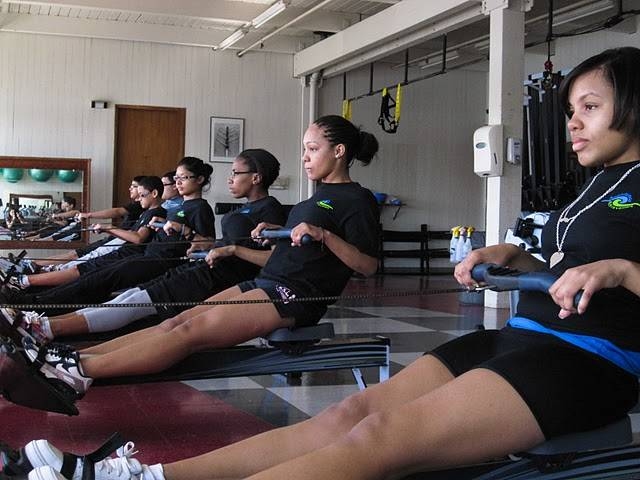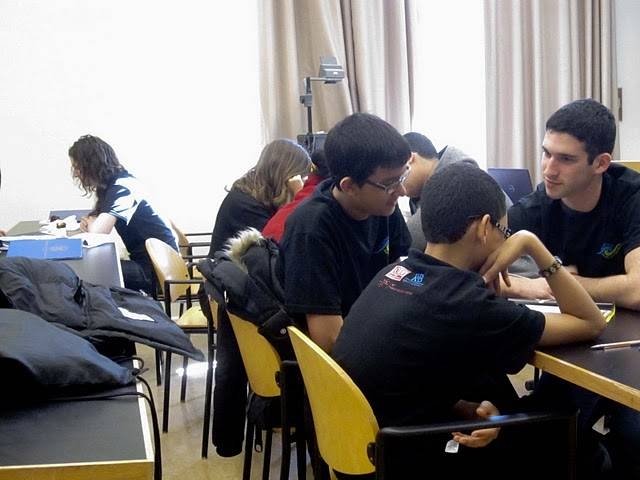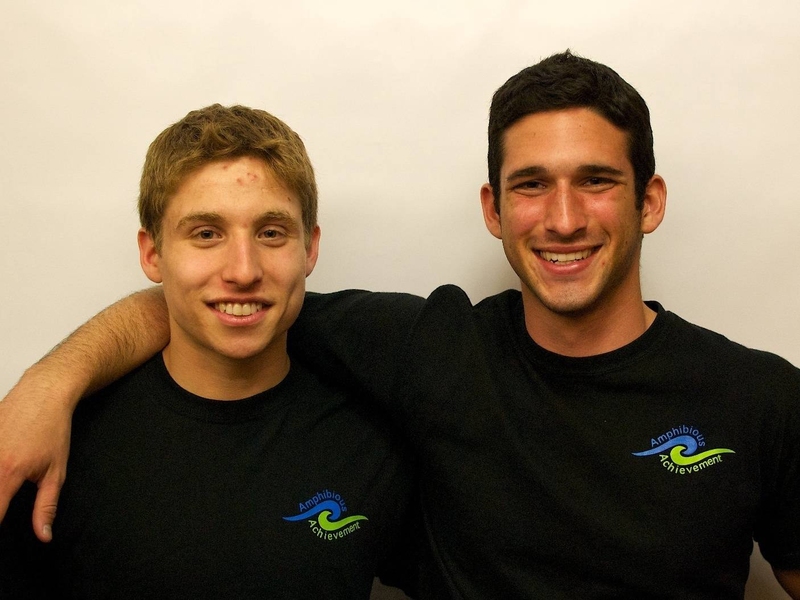It’s 9 a.m. on Sunday morning and the otherwise peaceful Infinite Corridor is electrified by 20 high school and MIT students chanting, “we are Achievers, Amphibious Achievers!”
The chant has become a trademark of Amphibious Achievement, a dual athletic and academic mentorship program that brings 18 high school students from the John D. O’Bryant School in Boston to MIT every Sunday. The goal of the program is to promote “success in and out of the water” through aquatic sports, generally inaccessible to inner-city high school youth, and through SAT-based tutoring.
This connection between athletics and academics was what two MIT sophomores, Noam Angrist and Ron Rosenberg, were looking to tap into when they founded Amphibious Achievement. Both Angrist and Rosenberg have been coaches and athletes in crew and swimming, respectively, throughout their lives. As athletes, they learned about the benefits of sport first hand. As coaches, the benefits became even clearer.
“After each of my seasons coaching, naturally the kids became better athletes, but parents told me that their kids also became more disciplined in school and more respectful at home,” Rosenberg said.
“We wanted to latch on to the spillover effects of athletics in a meaningful way,” Angrist said. “We realized, however, that there wasn't a program [at MIT] that provided that outlet. So, we created one.”
The program runs every Sunday, beginning with the two-hour athletic portion. Swimmers are taken to the Olympic-sized aquatic facilities at the Zesiger Center, while rowers are taken to MIT’s Division I Pierce Boathouse.
The MIT student coaches focus on developing technical skills early on in the program through unconventional drills. Rowers learned the basics of rowing posture and body swing via rocking back and forth on an ergometer to the rap song “Lean with it, Rock With it.” At the same time, swimmers learn body alignment through static and dynamic yoga exercises out of the water. Further on the students focus on stamina training that culminate in competitive relays.
For Achiever Ernest Mejia, the skills he gains as an athlete are especially meaningful, “[rowing] has been good for me. It has also taught me various skills that I can apply in the classroom such as motivation, teamwork, ethics and perseverance.”
The lessons learned in athletics are transferred to academics as Achievers transition to the classroom after eating lunch. The academic portion is guided by a unique 60-page curriculum, drawn up by Academic Coordinators and sophomores Camila Caballero and Kimberly Aziz. “The curriculum is challenging,” Caballero said, “we set the bar very high.” In the critical reading portion, for example, Achievers read The Economist, answer SAT-style questions about the article, which are prepared beforehand by their tutor, and present to the class both key ideas and relevant connections to the outside world.
Aziz and Caballero have also enhanced the lesson material with interactive activities. Using YouTube clips that combine complicated math concepts with pop culture they are able to teach problem solving skills and keep the students interested. Similarly, in the grammar portion, Aziz and Caballero have introduced a competitive Jeopardy!-style game where students compete in teams to revise sentences on the board, and then explain their revisions for equal credit, in the shortest amount of time. At the end of the day, Aziz and Caballero also hand out “Opportunities to Achieve,” small at-home assignments that team members can score points on upon completion.
These activities exemplify the four core ideas on which the curriculum is based: friendly competition, tangible incentives, advanced resources and high expectations.
Angrist and Rosenberg attribute the success of the program to Amphibious Achievement’s executive committee and Mentor Corps. “Our team is tremendous,” said Angrist and Rosenberg about the 13 MIT students that run the program. “Not only is every member passionate and talented, but we also have a lot of fun.” Maybe that explains the whimsical “We Are Achievers” chant.
Fueled by the program’s initial success, a third segment, Career Days, was recently launched. On a weekly basis, the Career Days team runs career-building and self-presentation workshops for the Achievers on the John D. O’Bryant School campus. “Most recently, the students have been working on the content and formatting of their resumes,” said Adie Angrist, a sibling of one of the founders and the Career Days coordinator for Amphibious Achievement. “When asked about activities for her resume, Achiever Dalesha St. Louis chuckled and said ‘but I don’t do anything.’ In five minutes Dalesha went from ‘I don’t do anything’ to realizing that she helped organize a bake sale that raised $200 for her Step Team’s uniforms.”
The program has already received national attention at Teach for America’s Lead Now Conference, a week-long leadership seminar for more than 550 nominated scholars. At the conference, Angrist was one of two student panelists, where he spoke about the unique structure and impact of Amphibious Achievement.
Amphibious Achievement has also garnered significant support from the community and is closely partnered with MIT’s Public Service Center, the COOP, Cosi, K&B Sportswear, MIT Athletics, and Au Bon Pain. Holly Metcalf, head coach of MIT Women’s Openweight Crew team and 1984 Olympic gold medalist, has further served as an advisor to the program. The support of local sponsors has been instrumental as Amphibious Achievement has continued to provide both youth and MIT students with a broad array of resources, including binders, books, T-shirts, sports equipment and food.
While eating lunch with the tutors, Denise, a devout Achiever, notes “The first thing I think of when I wake up for Amphibious Achievement is, 'Wow, it’s early and it’s Sunday,' which I never used to like, but now I do. I look forward to it.”
The chant has become a trademark of Amphibious Achievement, a dual athletic and academic mentorship program that brings 18 high school students from the John D. O’Bryant School in Boston to MIT every Sunday. The goal of the program is to promote “success in and out of the water” through aquatic sports, generally inaccessible to inner-city high school youth, and through SAT-based tutoring.
This connection between athletics and academics was what two MIT sophomores, Noam Angrist and Ron Rosenberg, were looking to tap into when they founded Amphibious Achievement. Both Angrist and Rosenberg have been coaches and athletes in crew and swimming, respectively, throughout their lives. As athletes, they learned about the benefits of sport first hand. As coaches, the benefits became even clearer.
“After each of my seasons coaching, naturally the kids became better athletes, but parents told me that their kids also became more disciplined in school and more respectful at home,” Rosenberg said.
“We wanted to latch on to the spillover effects of athletics in a meaningful way,” Angrist said. “We realized, however, that there wasn't a program [at MIT] that provided that outlet. So, we created one.”
The program runs every Sunday, beginning with the two-hour athletic portion. Swimmers are taken to the Olympic-sized aquatic facilities at the Zesiger Center, while rowers are taken to MIT’s Division I Pierce Boathouse.
The MIT student coaches focus on developing technical skills early on in the program through unconventional drills. Rowers learned the basics of rowing posture and body swing via rocking back and forth on an ergometer to the rap song “Lean with it, Rock With it.” At the same time, swimmers learn body alignment through static and dynamic yoga exercises out of the water. Further on the students focus on stamina training that culminate in competitive relays.
For Achiever Ernest Mejia, the skills he gains as an athlete are especially meaningful, “[rowing] has been good for me. It has also taught me various skills that I can apply in the classroom such as motivation, teamwork, ethics and perseverance.”
The lessons learned in athletics are transferred to academics as Achievers transition to the classroom after eating lunch. The academic portion is guided by a unique 60-page curriculum, drawn up by Academic Coordinators and sophomores Camila Caballero and Kimberly Aziz. “The curriculum is challenging,” Caballero said, “we set the bar very high.” In the critical reading portion, for example, Achievers read The Economist, answer SAT-style questions about the article, which are prepared beforehand by their tutor, and present to the class both key ideas and relevant connections to the outside world.
Aziz and Caballero have also enhanced the lesson material with interactive activities. Using YouTube clips that combine complicated math concepts with pop culture they are able to teach problem solving skills and keep the students interested. Similarly, in the grammar portion, Aziz and Caballero have introduced a competitive Jeopardy!-style game where students compete in teams to revise sentences on the board, and then explain their revisions for equal credit, in the shortest amount of time. At the end of the day, Aziz and Caballero also hand out “Opportunities to Achieve,” small at-home assignments that team members can score points on upon completion.
These activities exemplify the four core ideas on which the curriculum is based: friendly competition, tangible incentives, advanced resources and high expectations.
Angrist and Rosenberg attribute the success of the program to Amphibious Achievement’s executive committee and Mentor Corps. “Our team is tremendous,” said Angrist and Rosenberg about the 13 MIT students that run the program. “Not only is every member passionate and talented, but we also have a lot of fun.” Maybe that explains the whimsical “We Are Achievers” chant.
Fueled by the program’s initial success, a third segment, Career Days, was recently launched. On a weekly basis, the Career Days team runs career-building and self-presentation workshops for the Achievers on the John D. O’Bryant School campus. “Most recently, the students have been working on the content and formatting of their resumes,” said Adie Angrist, a sibling of one of the founders and the Career Days coordinator for Amphibious Achievement. “When asked about activities for her resume, Achiever Dalesha St. Louis chuckled and said ‘but I don’t do anything.’ In five minutes Dalesha went from ‘I don’t do anything’ to realizing that she helped organize a bake sale that raised $200 for her Step Team’s uniforms.”
The program has already received national attention at Teach for America’s Lead Now Conference, a week-long leadership seminar for more than 550 nominated scholars. At the conference, Angrist was one of two student panelists, where he spoke about the unique structure and impact of Amphibious Achievement.
Amphibious Achievement has also garnered significant support from the community and is closely partnered with MIT’s Public Service Center, the COOP, Cosi, K&B Sportswear, MIT Athletics, and Au Bon Pain. Holly Metcalf, head coach of MIT Women’s Openweight Crew team and 1984 Olympic gold medalist, has further served as an advisor to the program. The support of local sponsors has been instrumental as Amphibious Achievement has continued to provide both youth and MIT students with a broad array of resources, including binders, books, T-shirts, sports equipment and food.
While eating lunch with the tutors, Denise, a devout Achiever, notes “The first thing I think of when I wake up for Amphibious Achievement is, 'Wow, it’s early and it’s Sunday,' which I never used to like, but now I do. I look forward to it.”








